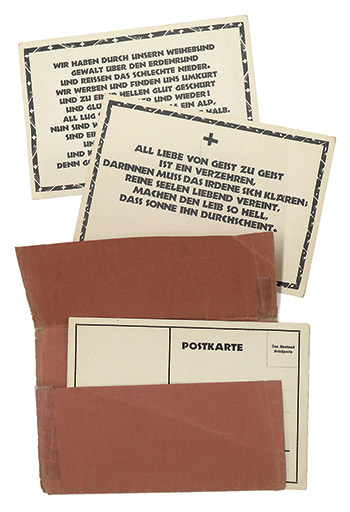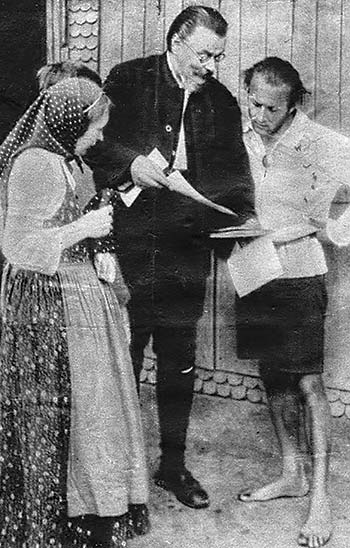Subtotal: $
Checkout-

Plough at One Hundred Years
-

Saint Macrina
-

Another Life Is Possible: Four Stories from 100 Years of Life Together
-

Covering the Cover: Solidarity
-

Solidarity in Forgiveness
-

Readers Respond: Issue 25
-

Family and Friends: Francis Schaeffer and L’Abri
-

We Must Not Stand By
-

Deep Solidarity
-

The Church Is Other People
-

Black Lives Matter and the Church
-

Traveling Inside
-

The Solidarity of Grief
-

Dinotopian Visions
-

Solidarity Means Giving Yourself
-

Acts 2 in Bolivia
-

Two Poems
-

Two Sonnets
-

The Prayers of the Chinese Nature Painters
-

Chaim Potok’s Wandering Jews
-

How to Read Dickens

This article first appeared in Plough’s Autumn 2020 issue.
This year both Plough Publishing House and the Bruderhof communities mark the hundredth anniversary of their founding. Both had their origin in Neuwerk (New Work), a Christian socialist youth movement in Germany after World War I in which Eberhard Arnold, Plough’s founding editor, was a leading figure. Vollmer, author of a 2016 book on Neuwerk, tells the story in this adapted excerpt.
In the spring of 2014, I received a surprising phone call. One hundred years after the outbreak of the First World War, a pastors’ conference of the Protestant Church in Hesse and Nassau was reflecting on the war’s consequences for their region and came across my doctoral thesis. I was astonished: forty-one years had passed since the writing of this dissertation and it had never appeared in print. At that time, my doctoral supervisors Helmut Gollwitzer and Karl Kupisch suggested that I investigate one of the most interesting groups among the youth movements that emerged from the catastrophes of the First World War, whose members had exercised significant influence on the International Fellowship of Reconciliation, religious socialism, and the Confessing Church. This research was now all part of my distant past. Historians researching individual members or the movement as a whole had occasionally asked me for my dissertation to use as a source, but I did not want to give away my last personal copy. How could a Hessian pastors’ conference even know of it?
It turned out that, in 2002, some members of the group whose beginnings I had researched had returned to the house in Germany where their movement started, after all kinds of odysseys – expulsion by the National Socialists in 1937, a stopover in England, building of new settlements in Paraguay, and a temporary union with the Hutterite Brethren. Now they were again in the same Sannerz villa where everything began in 1920 when Eberhard Arnold moved in: the first Pentecost meetings with up to a thousand young participants, the first communal Bruderhof settlement, the creation and distribution of their own progressive magazine.
Before that phone call I had not heard anything about their return and this new beginning. I wanted to experience this for myself and so, before going to the pastors’ conference, I visited the refounded Bruderhof. There I met many young people who happened to be visiting and wanted to experience the roots of their community for themselves. I was surprised to hear these guests – coming from many countries – singing the old songs of the youth movement in the original German by heart and powerfully, as if one hundred years of complicated European history had not intervened. In the end, no doubt remained: here was, still or again, the Bruderhof movement, at its beginning identical with the Neuwerk movement, which I had once treated as a historically completed process. Today it has about three thousand members worldwide.

Postcard set designed by Otto Salomon, published by Neuwerk. Bruderhof Historical Archive
In conventional Protestant church historiography, the Neuwerk movement has remained largely unknown over the past century, although its circle and its published writings included such prominent personalities as the theologians Karl Barth and Paul Tillich; the social philosopher Eugen Rosenstock-Huessy; the economist Eduard Heimann; the social worker Gertrud Staewen; and the Christian socialist Helmut Gollwitzer. This relegation to obscurity may seem surprising at first glance, but it is a fate that the Neuwerk movement shares with quite a number of progressive social movements from the short Weimar period between the world wars, including labor movement organizations, trade unions, nature conservation and sports movements, women’s associations, and many creative cultural groups. Some of them fell into oblivion because they were ultimately considered unsuccessful in the face of the rise of National Socialism, while others were denounced as conscious or unconscious forerunners of that era. This applied to many groups of the youth movement, whose culture and way of life were later almost completely appropriated by the Nazi youth associations, which sought to benefit from their undeniable charisma and attractiveness to young people. And yet it is worth a closer look to avoid over-hasty historical condemnations. What was imagined and hoped for in those hard years between the wars – what visions for a more just world were dreamed of, and what daring reform projects were undertaken – still deserves our unbiased interest.
The main source of information about the history of the Neuwerk movement lies in the almost completely preserved fifteen volumes of the magazine Das neue Werk (The New Work), which gave the movement its name and appeared between 1919 and 1935 with about five hundred closely printed pages per year. It reflects the lively discussion through which the members and protagonists of the Neuwerk movement tried to live up to the challenges of their time. This included examining the causes of World War I; orienting the youth movement in its own self-determination between nationalist and communist tendencies; exploring questions of pacifism and a just social order; and calling for communal settlements, worker education, progressive schools, and ongoing adult education.
The magazine also included precise descriptions of the social situation of workers and the unemployed in the large cities and analyses of the threats to democracy from the instability of the Weimar Republic and the world economic crisis. Especially in the early years, the language of many articles is remarkable: fresh, charismatic, rapturous, excited, polemical.
In retrospect, it seems to me that my early research in this area prepared me well for the language, themes, struggles, passions, life experiments, and characters that I met ten years later among the first Green Party members in the German parliament.
The beginning of Neuwerk would have been unthinkable without Eberhard Arnold. He managed, within a short time, to set so many young people all over Germany on fire for his cause that two to three hundred of them answered his invitation to a Pentecost conference in 1920 – the Neuwerk movement’s hour of birth.
All who knew Eberhard Arnold speak of the extraordinary strength his person radiated, of his enthusiastic faith, which was the faith of Jesus’ Sermon on the Mount, and of his radical way of carrying out the task he knew himself called to. H. J. Schoeps, a Jewish member of the German Youth Movement during the 1920s, describes him in his memoir:
I remember a very tall man of about forty-five in corduroy clothes, with radiant brown eyes, which gazed down at you in a friendly but also challenging way. He looked unusual in every respect. Once when he was standing in front of the National Library in Berlin, curious Berliners formed a proper circle around him and just stared at him. . . . I state without hesitation that powers from another world were at work here, and Eberhard Arnold was their chosen instrument. If he had lived a few centuries earlier and as a Catholic, he would now most likely have a place assigned to him in a saints’ calendar.
Before World War I, Eberhard and his wife Emmy had been leading figures in Germany’s evangelical revival movement. Called up for military service when war broke out, he was discharged because of severe tuberculosis and took a job in Berlin as editor at a Christian publishing house.

Eberhard Arnold (center) looking over a manuscript for typesetting Bruderhof Historical Archive
The 1919 revolution confirmed the Arnolds’ determination, which had grown during the war, to try to close the rift between a radically understood Christianity and the endeavor to socially revolutionize the world. From this time on there were open evenings in their Berlin townhouse, attended by up to a hundred young people at a time: anarchists as well as members of Christian youth associations, atheists and Quakers, proletarians and intellectuals. All of them were looking for a new meaning for human existence and for new forms of life that would strengthen peace and social justice. They read and discussed Tolstoy, Dostoyevsky, and, repeatedly, the Sermon on the Mount.
From 1919 to 1920, Arnold grew to believe more strongly that the new vision of a radical Christianity could not remain just a theory, but that it compelled him to give up his bourgeois existence in Berlin and search for new, original forms of living.
Shortly after the Pentecost conference, on June 21, 1920, the Arnolds took over a villa in the village of Sannerz in Hesse, to build up an intentional community there in the spirit of the Neuwerk movement. Describing his vision for his new “settlement,” Eberhard wrote in a 1920 letter:
The important thing is that our religious-social movement and our young people, freely moved by Christ as they are, feel the urge to work together and to live in community. We need a center out in the country for our life, where we offer hiking groups a good place to stay and where we can at the same time bring together different work groups for the purpose of productive work and of mutual exchange of goods. What we have in mind is a community of life that is to have a common table and be a community of work, of goods, and of faith.
The Neuwerk movement’s magazine and publishing house are the predecessors of Plough’s magazine and book publishing. The Gestapo forcibly dissolved both the community and publishing house in 1937, but the “New Work” carried on in England, where the first issue of the renamed English-language magazine The Plough would appear in March 1938.
Abridged translation by Kim Comer of excerpts from Antje Vollmer, Die Neuwerkbewegung: Zwischen Jugendbewegung und religiösem Sozialismus (Herder, 2016).
Antje Vollmer was a Protestant pastor and a politician in Germany’s Green Party. From 1994 to 2005 she was vice president of the nation’s parliament.
Already a subscriber? Sign in
Try 3 months of unlimited access. Start your FREE TRIAL today. Cancel anytime.































Peter King
What an interesting article. It would be lovely to read an English translation of Antje Vollmer's book !
Greg Bourn
Thank you for that brief history of Plough.